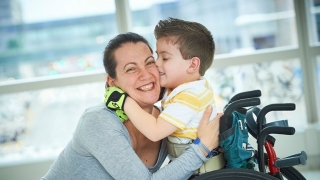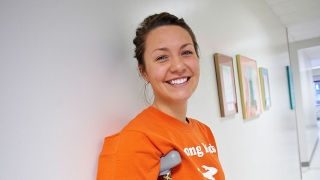Congenital Short Femur
What is congenital short femur?
Congenital short femur is a rare type of congenital malformation that occurs during prenatal development and affects the growth of the femur bone in the upper leg. The femur may be slightly smaller or much smaller than the other leg, producing leg-length discrepancies, hip and knee instability, and a range of functional complications.
Because of the range in severity of this condition, an experienced, multidisciplinary team must carefully evaluate a child with congenital short femur and develop a customized treatment plan to address the child’s specific needs. No single treatment is effective for all children.
Treatment may include surgery, leg-lengthening procedures with fixation devices, prosthetics, or a combination of these treatments. The goal of treatment is to increase the child’s functional use of their leg.
Congenital short femur is considered a form of proximal femoral focal deficiency.
Causes of congenital short femur
The causes of congenital short femur remain largely unknown and the disorder does not appear to be genetically linked. In most cases, researchers suspect congenital short femur is caused by a disruption during early prenatal development, which can be caused randomly, or as a result of an outside force such as an infection or trauma.
Symptoms of congenital short femur
While the severity of congenital short femur can vary, the main symptom is what its name implies — a shortened femur bone that is present at birth. The affected femur may also be externally rotated (turned outward), flexed and abducted (leg pivots from the hip at an abnormal angle).
Congenital short femur can cause instability in the hip or knee joint of the affected leg and may be linked to other anomalies such as fibular deficiency, knee instability, ACL deficiency, flat feet and clubfoot. In most cases, the disorder only affects one leg.
Testing and diagnosis
Children with congenital short femur are generally diagnosed at birth when the difference is obvious. Some may be diagnosed before birth using prenatal imaging. No matter when the disorder is first identified, the clinical appearance is similar: a shortened femur that often is also externally rotated, flexed and abducted.
At Children’s Hospital of Philadelphia, a trained pediatric orthopedic physician will perform a physical and visual examination of your child, and get a complete medical history. The goal of evaluation is to better understand your child’s anatomy, functional abilities and severity of the condition.
In many cases, doctors will order imaging tests such as:
- X-rays, which produce images of bones.
- EOS imaging, which creates 3-dimensional models from two flat images. EOS images are taken while the child is in an upright or standing position, enabling improved diagnosis due to weight-bearing positioning.
- Computed tomography (CT) scan, which uses a combination of X-rays and computer technology to examine bones and produces cross-sectional images ("slices") of the body.
- Magnetic resonance imaging (MRI), which uses a combination of large magnets, radiofrequencies and a computer to produce detailed images of organs, soft tissues, muscles, ligaments and other structures within the body. Your child is exposed to no radiation during an MRI.
- Hip arthrography, which uses X-rays and dye injected into the joint to show the soft tissues (ligaments, tendons, cartilage and muscles) of the joint.
- Ultrasound, which uses sound waves to produce images of organs and soft tissues inside the body.
Imaging tests can determine if your child has true congenital short femur or a more serious type of proximal femoral focal deficiency.
Treatment for congenital short femur
Treatment for congenital short femur varies from child to child and is based on:
- Your child’s age, overall health and medical history
- The severity of your child’s condition
- The condition and stability of your child’s hip, knee and foot
At Children’s Hospital of Philadelphia, a multidisciplinary team of pediatric orthopedic surgeons, nurses, prosthetists and physical therapists collaborate to create a customized treatment plan that may include surgery, staged limb-lengthening procedures and prosthetics to address your child’s functional defects.
The goal of treatment is to improve your child’s overall function so they can move and develop at a pace similar to their peers.
While the timing of treatment varies from child to child, in most cases it begins when your child turns 3 years old — allowing time for early bone to harden — and is completed by the end of high school, when most children have finished growing.
Limb-lengthening
Many children with congenital short femur can benefit from limb-lengthening procedures. To be eligible for limb lengthening, a child must have:
- A limb with a predicted discrepancy at skeletal maturity of no more than 20 centimeters (roughly 8 inches)
- A stable hip, or one that can be made stable
- Good function and stability in the knee, ankle and foot
Limb lengthening typically includes surgery to cut the bone, and then fixators are attached to the leg to slowly stretch the limb as new bone forms. While traditional treatment includes external fixators, orthopedic surgeons at CHOP are using a new internal technique for limb lengthening that eliminates the need for pins and bulky external fixation frames. Depending on how fast your child’s bone grows; this limb-lengthening procedure can take months and may need to be repeated.
Your child’s physician will determine the timing and staging of limb lengthening.
Prosthetics
If limb lengthening is not appropriate for your child — either because their leg-length discrepancy is too great or they will not tolerate the procedures — prostheses should be considered.
Initial treatment for children with congenital short femur should mirror normal development and begin when a toddler is ready to stand. The child is fitted with a custom-molded prosthesis that equalizes leg lengths but does not require surgical correction. In most cases, these prostheses are not large enough to accommodate flexing at both knee and foot, so developmental growth can be slower. However, a custom-molded prosthesis that accommodates the child’s lower extremity is effective at allowing young children to move around and explore their space.
Additional surgical procedures
As the child grows, the importance of having both a functional knee and foot becomes more important. At this time, decisions must be made about which type of prosthetic is most appropriate and what is the best surgical approach to accomplish that goal.
Depending on your child’s condition, doctors may recommend either an above-the-knee prosthesis with a mechanical knee or — if a biologic knee can be salvaged or created — a below-the-knee prosthesis.
Additional surgical options include:
- Knee arthrodesis, in which the knee joint is fused to adjacent bones (femur and tibia) allowing for a longer and more stable leg that can be more easily contained within the prosthesis.
- Foot amputation, in which the leg is shortened to accommodate a mechanical knee and the end of the leg can be more easily contained within a prosthesis.
- Rotationplasty, in which the ankle assumes the function of a knee. To accomplish this, the limb is surgically cut, rotated 180 degrees and reattached. This allows for improved function due to the use of a biologic knee instead of a mechanical one, and the need for a below-the-knee prosthetic.
- Hip stabilization, in which the hip socket (acetabulum) and femoral head are surgically corrected to address varus deformity (outwardly turned legs) and bone fractures that won’t mend without intervention (pseudoarthrosis).
- Iliofemoral arthrodesis, in which the knee assumes the function of the hip. In this procedure, the femur is fused to the pelvis so when the child extends their anatomic knee, they are effectively moving their hip. This procedure is often performed as part of a staged reconstruction with rotationplasty or foot amputation to allow for improved prosthesis fit and enhanced function.
- Hip/pelvic osteotomy, in which a shallow hip socket is reshaped to create better coverage of the ball of the thigh bone. This procedure is often used to treat acetabular dysplasia. During surgery, the surgeon cuts the bones in the hip joint, reorients them, and secures them in a new position.
Safety in surgery
Surgery can dramatically improve the long-term outcomes for your child with congenital short femur, but it can also be a stressful experience for you and your child.
At CHOP, we offer a wealth of resources that can help you and your child prepare for surgery. Additionally, we follow many best practices before, during and after surgery to decrease the risk of infection and increase positive outcomes. Our safety protocols have been so successful that many other institutions have adopted them.
To learn more, read how we make safety in surgery a top priority.
Follow-up care of congenital short femur
Children with congenital short femur will need follow-up care until adolescence, and sometimes into adulthood. The staged nature of treatments requires ongoing monitoring and care to determine optimal timing for each phase and determine if treatments are working as planned.
At Children's Hospital of Philadelphia, we offer a wealth of ongoing support and services for your child and family at our Main Campus and throughout our CHOP Care Network. Our team is committed to partnering with you to provide the most current, comprehensive and specialized care possible for your child.
We recognize your child's pediatrician as an important part of the clinical team and provide regular updates on your child's progress. If continued care and monitoring is necessary long-term, we will help transition your child's care to an adult orthopedic team.
Outlook
Long-term outcomes for children with congenital short femur depend largely on the severity of the condition and how well the child responds to treatment. Some children may need several surgeries and have lingering issues as they grow. Many children treated for congenital short femur can live long, active and full lives.
Reviewed by Alexandre Arkader, MD, B. David Horn, MD




